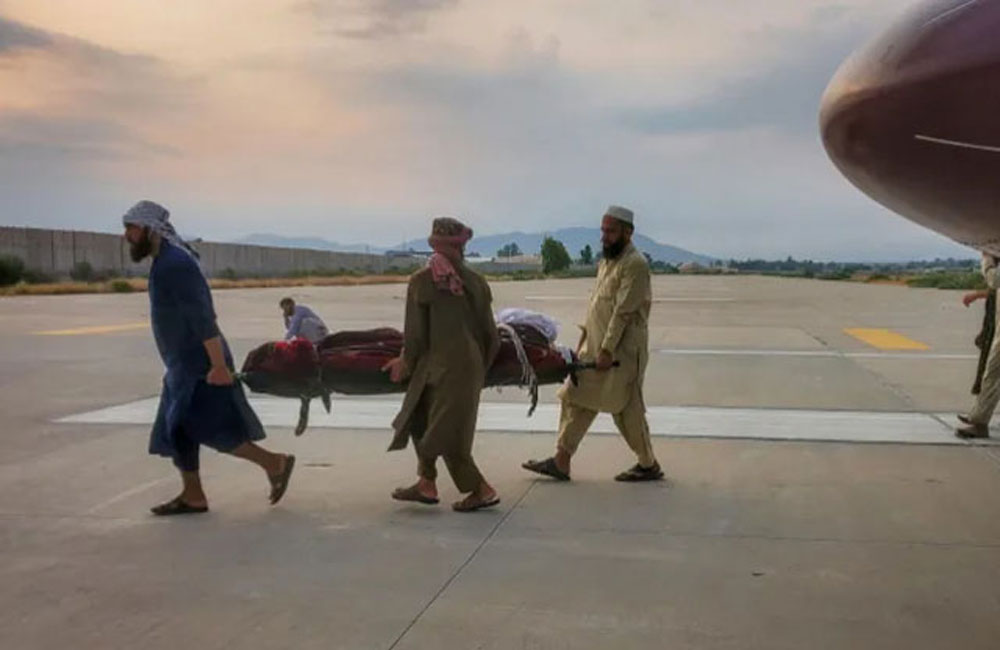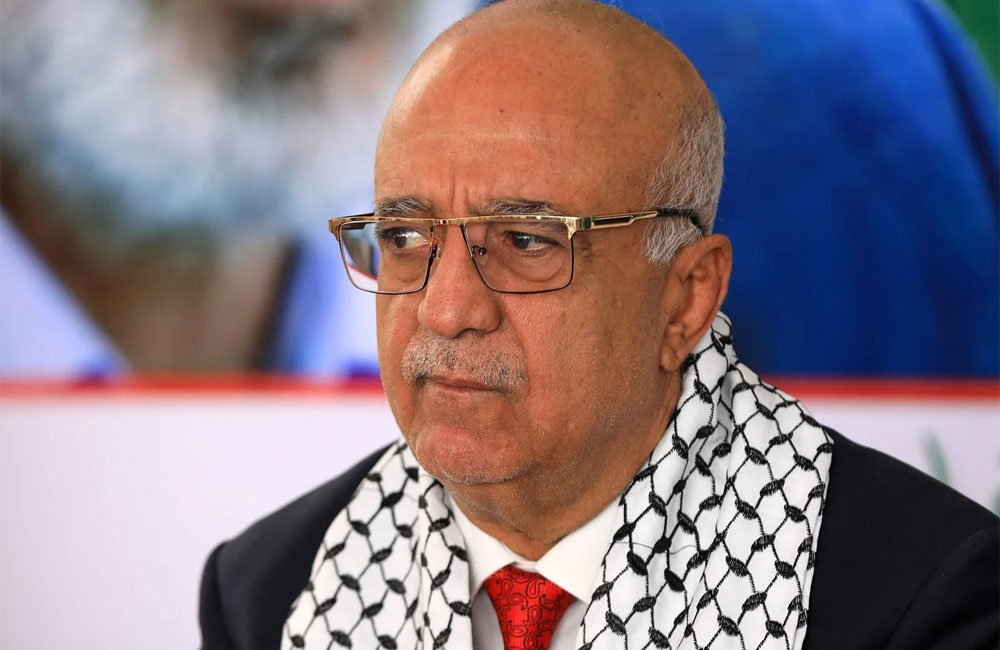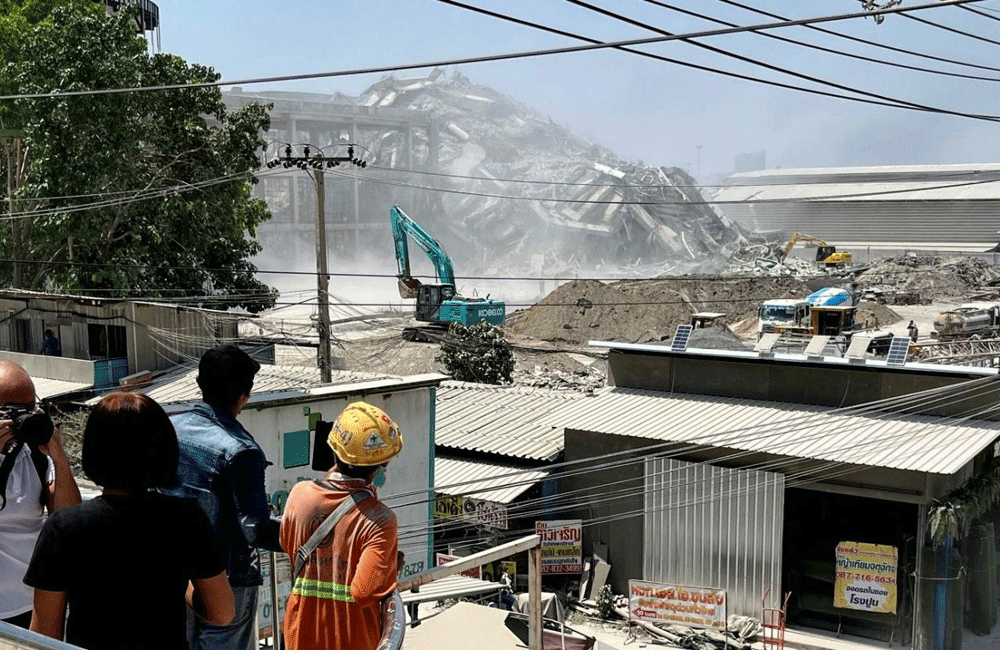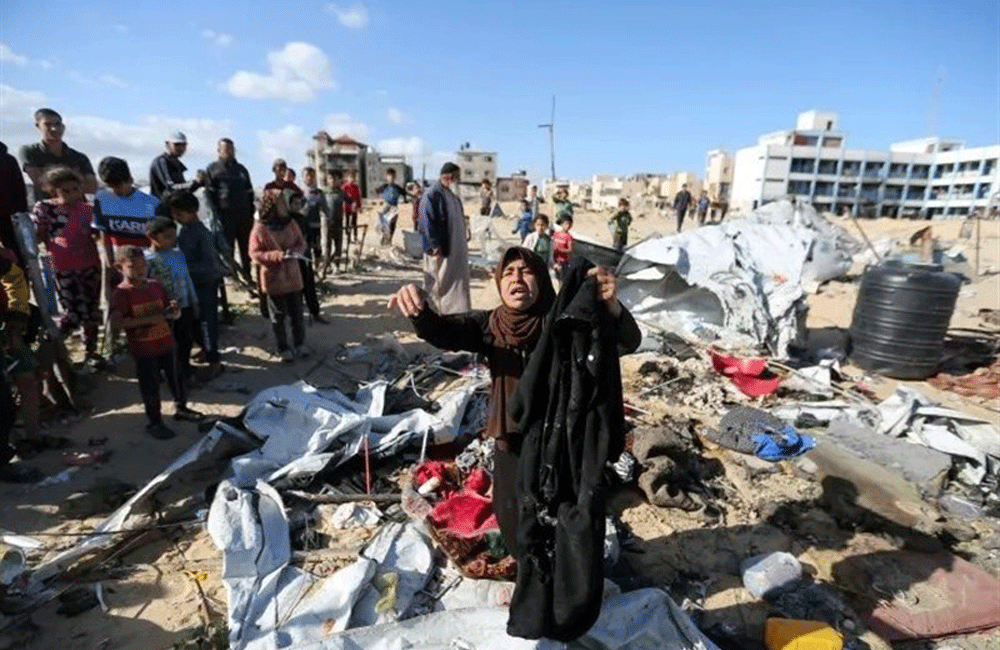World

More Than 800 Killed In Afghanistan Quake
(BBC) More than 800 people are feared dead after a magnitude 6.0 earthquake hits eastern Afghanistan, the Taliban interior ministry reports.
The quake, at a shallow depth of 8km (6 miles), shook buildings from Kabul to Pakistan's capital Islamabad .
The remote area where it struck makes providing accurate estimates hard, as officials warn of high casualty figures.
Dozens of houses are "under rubble", sources from the Taliban government say, while officials report entire villages being destroyed.
The earthquake's epicentre was 27km (17miles) away from Jalalabad, Afghanistan's fifth-largest city, and around 140km (87 miles) from the capital Kabul.
The area is mountainous with limited communications, which means information is emerging slowly.

China to increase tariffs on US goods to 125% up from 84%
Beijing on Friday increased its tariffs on U.S. imports to 125%, hitting back against U.S. President Donald Trump's decision to hike duties on Chinese goods to 145%, raising the stakes in a trade war that threatens to up-end global supply chains.
The hike comes after the White House kept the pressure on the world's No.2 economy and second-biggest provider of U.S. imports by singling it out for an additional tariff increase, having paused most of the "reciprocal" duties imposed on dozens of other countries.
(Reuters)

Israeli airstrike kills Houthi rebel prime minister in Sanaa
The Iranian-backed Houthis said Saturday an Israeli airstrike killed the prime minister of the rebel-controlled government in the Yemeni capital, Sanaa.
Ahmed al-Rahawi was killed in a Thursday strike in Sanaa along with a number of ministers, the rebels said in a statement.
The Israeli military said Thursday that it “precisely struck a Houthi terrorist regime military target in the area of Sanaa in Yemen.”
Al-Rahawi, who served as prime minister to the Houthi-led government since August 2024, was targeted along with other members of his Houthi-controlled government during a routine workshop held by the government to evaluate its activities and performance over the past year, the rebels’ statement said.
The Houthis have repeatedly launched missiles against Israel throughout Israel’s war against Hamas in Gaza. The group says the attacks are in solidarity with the Palestinians. Though most of the missiles launched by Yemen are intercepted by Israel, or fragment mid-air, this has done little to deter the attacks.
Earlier in the week, Israeli strikes hit multiple areas across Sanaa, killing at least 10 people and wounding 102 others, according to the Houthi-run health ministry and government officials.
The Houthis have launched missiles and drones toward Israel and targeted ships in the Red Sea throughout Israel’s war against Hamas in Gaza. The rebels say their attacks are in solidarity with the Palestinians.
In response to the Houthi attacks, Israel and a U.S.-led coalition pounded the rebel-held areas in Yemen, including Sanaa and the strategic coastal city of Hodeida. Israeli strikes knocked the Sanaa airport out of service in May.
The Trump administration announced a deal with the Houthis to end the airstrikes in return for an end to attacks on shipping in May. The rebels, however, said the agreement did not include halting attacks on targets it believed were aligned with Israel.
Source: AP --
Agencies

Earthquake of magnitude 6.0 strikes Japan’s Kyushu
Earthquake of magnitude 6.0 strikes Japan’s Kyushu, the Japan Meteorological Agency said that the earthquake struck at 7.34 (local time) at a depth of 40km.
The earthquake comes days after a 7.7-magnitude earthquake flattened buildings across Myanmar, killing more than 2,800 people and making thousands more homeless.
On Monday, a report by the Japanese government said that a “megaquake” and subsequent tsunami could cause as many as 298,000 deaths in Japan and damage costing up to $2 trillion.
A “megaquake” refers to an extremely powerful earthquake, typically magnitude 8 or higher, capable of causing widespread destruction and potentially triggering a tsunami.
The updated figures revise a 2014 estimate that assessed the potential impact of a massive earthquake along the Nankai Trough, an 800-kilometer (500-mile) undersea trench stretching from Shizuoka, west of Tokyo, to the southern tip of Kyushu.
This trench is where the Philippine Sea tectonic plate is gradually subducted beneath the continental plate on which Japan rests. Over time, the plates become locked, accumulating energy that is eventually released in the form of major earthquakes.
In August last year, the Japan Meteorological Agency (JMA) issued its first-ever “megaquake advisory” under post-2011 rules, following a magnitude 7.1 earthquake in southern Japan that injured 14 people.
Earlier in January of the same year, a massive earthquake struck Japan’s Noto Peninsula, killing at least 260 people, including 30 quake-related deaths.
Source: The Hindustan Times
--Agencies

Frank Caprio: ‘Nicest judge in the world’ dies after cancer diagnosis
A US judge who amassed a huge online fan base via clips of his compassion in the courtroom has died.
Frank Caprio was on the bench at a court in Providence, Rhode Island, for almost four decades.
He became affectionately known as the “nicest judge in the world”, NBC Boston reported, after viral videos of him handing out justice with a smile were viewed more than a billion times on social media.
The latter years of his career, which ended in 2023, were documented in the TV show Caught In Providence.
A statement on Wednesday on his Instagram page, which had 3.2 million followers, said he had died aged 88 “after a long and courageous battle with pancreatic cancer”.
It said he was “beloved for his compassion, humility, and unwavering belief in the goodness of people”.
He had posted a message from his hospital bed the day before, saying: “Unfortunately I’ve had a setback, I’m back in the hospital now, and I’m coming to you again asking you to remember me in your prayers once more.”
Caprio’s persona was at odds with my fellow TV judges, who were less sympathetic and more confrontational. In one popular clip, he dismissed a traffic ticket handed to a bartender who skipped a red light, as they were only earning less than $4 (£2.97) an hour.
Another saw him listening sympathetically to a woman whose son had been killed, before dismissing her tickets and fines which had totalled $400 (£297).
Caprio also used his fame to speak out about inequality in the justice system.
“Almost 90% of low-income Americans are forced to battle civil issues like health care, unjust evictions, veterans benefits and, yes, even traffic violations, alone,” he said in one video.
After his death was announced, Rhode Island Governor Dan McKee paid tribute to his “warmth and compassion”.
“He was more than a jurist - he was a symbol of empathy on the bench, showing us what is possible when justice is tempered with humanity,” he said.
Source: Sky News
--Agencies

Bangkok Declared Emergency Zone After Powerful Quake
The Thailand prime minister has declared Bangkok an emergency zone after a 7.4-magnitude quake rocked Bangkok this afternoon.
Paetongtarn Shinawatra was in Phuket province when the tremor rocked the capital.
At least a worker was killed and 43 others missing when a building under construction in Bangkok collapsed this afternoon.
A viral video clip showed the under-construction building collapsing in Chatuchak district, scattering debris around the area.
The Thai Meteorological Department reported that the midday tremor was a shallow one, at a depth of 10 kilometers, with its epicenter in neighboring Myanmar.
A viral video clip showed the under-construction building collapsing in Chatuchak district, scattering debris around the area.
Another video clip showed water from a rooftop swimming pool of a high-rise condominium splashing down.
The tremor could be felt even on the second floor of the Thai PBS World office on Vibhavadi Rangsit Road.
Telephone and internet signals were also disrupted during and after the quake.
MRT’s blue and purple lines in Bangkok suspended their services shortly after the quake.
Witnesses said members of communities huddled together to discuss what they described as an unprecedented experience.
People evacuated buildings, with even those living in one- or two-story homes running out of their residences and refusing to go back inside.
At a Bangkok café, ceiling lights swayed, and many doors opened and closed by themselves.
Car drivers said they felt the streets move. “It was so scary,” one said. “I thought my swinging-house syndrome (vertigo) was coming back to attack me.”
People called friends and family members to check about their well-beings. Internet or phone disruptions amplified fear and worries.
Source: Thai PBS

Italy’s Mount Etna erupts as large plumes rise from volcano
Italy’s Mount Etna has erupted, with large plumes of ash and smoke seen rising from the volcano.
Images and video from the island of Sicily showed volcanic material spilling out of the volcano on Monday morning.
A number of explosions of “increasing intensity” were recorded in the early hours on Monday morning, Italy’s National Institute of Geophysics and Volcanology (INGV) Etna Observatory said.
The full scale of the eruption is currently unclear and disruption appears to be minimal.
Mount Etna is one of the world’s most active volcanoes, so eruptions are not uncommon and its outbursts rarely cause significant damage or injury.
Ground movements indicated latest eruption happened on the south eastern edge of the volcano, according to INGV. This appears to be where a known 200m-wide vent is.
Footage shared throughout Monday shows a rapidly moving mix of ash, gas and rock - known as a pyroclastic flow - emerging from the site and moving down the side of the volcano.
Geologists monitoring the eruption said it was likely that part of volcano’s crater collapsed and that this was the material being carried down its slopes.
Pyroclastic flow can be very dangerous to the surrounding area, but there has been no indication of an imminent threat.
In its most recent update, INGV noted that the volcanic material had not yet gone past the Valley of the Lion, the point on the approach to the summit where tourist trips stop.
INGV said it first recorded changes in the volcano’s activity at 00:39 local time (22:39 GMT), before clarifying that there was an ongoing “Strombolian” eruption.
The size of Strombolian eruptions can vary but are often characterised by intermittent explosions, which occur due to the presence of gas in the magma chamber within the volcano.
When the gas bubbles reach the surface, they can burst suddenly, throwing material skywards. The process is not dissimilar to letting gas out of a fizzy drink.
These types of eruptions can be particularly dangerous for nearby aircraft.
A red alert was reportedly issued earlier on Monday, possibly suspending flights operating nearby, but this was later downgraded.
Mount Etna’s last notable eruption came in February and caused the island’s Catania airport to divert dozens of flights because of ash clouds.
Tourists were also warned to stay away from the volcano’s lava flows.
Source: BBC
- Agencies

Israel keeps pounding Gaza for second day
At least 24 Palestinians have been killed in Israeli air attacks across the Gaza Strip overnight and this morning.
Israeli attacks in Gaza have rendered about 85 percent of the enclave’s water and sanitation facilities fully or partially inoperative, according to the Palestinian Central Bureau of Statistics.
As a result, Gaza’s water supply has fallen by 65 percent since the start of the war, leaving residents with just three to five litres (0.7 to 1.3 gallons) per person daily, reports the bureau.
This falls far below the World Health Organization’s minimum humanitarian standard for emergencies, set at 15 litres (nearly 4 gallons) per person per day.
Israel’s Foreign Ministry has accused UN chief Antonio Guterres of “moral bankruptcy” after he said he was “outraged” by renewed Israeli air strikes in Gaza.
“We are outraged that you [Antonio Guterres] are the Secretary-General of the UN,” Foreign Ministry spokesman Oren Marmorstein wrote on X.

Magnitude 7.4 earthquake strikes off coasts of Chile, Argentina
A magnitude 7.4 earthquake has struck off the southern coasts of Chile and Argentina, the United States Geological Survey (USGS) says.
Chilean authorities issued an evacuation alert on Friday for the entire coastal section of the Strait of Magellan, in the far south of the South American country.

x-PM Imran Khan, wife sentenced to jail in corruption case
Pakistan’s former Prime Minister Imran Khan was today sentenced to 14 years in prison, and his wife Bushra Bibi to seven years in a case related to the misuse of authority and corruption involving Khan’s Al-Qadir University Project Trust.
Khan was also given a fine of 1 million Pakistani rupees ($3,500), while Bibi was fined half that amount.
An accountability court operating from Adiala Jail in Rawalpindi, where Khan has been imprisoned since August 2023, had reserved its verdict in December last year and deferred the announcement three times. Bibi was arrested from the court premises.
Khan, who did not appear before the court on January 13 when the decision was delayed for a third time, had earlier claimed the delays were an attempt to “pressurise” him.
This marks the fourth major case in which the former prime minister has been convicted.
Three earlier convictions, announced in January last year, were related to selling state gifts, leaking state secrets, and unlawful marriage, all of which were overturned or suspended. Despite this, Khan remains behind bars, with dozens of cases pending against him – a situation he describes as a political witch-hunt.
Khan was first arrested in connection with the Al-Qadir Trust case in May 2023, spending less than two days in detention. However, the arrest led to nationwide protests during which Khan’s supporters rioted in multiple cities.
Faisal Fareed Chaudhry, Khan’s lawyer, condemned the decision as a continuation of “bogus persecution” against Khan and his wife.

India bans 16 Pakistani YouTube channels for spreading misinformation
India has banned 16 Pakistani YouTube channels, including Dawn News, Samaa TV, Ary News and Geo News, for disseminating misinformation against India in the backdrop of the recent Pahalgam terror attack.
The YouTube channels have been banned for spreading provocative and communally sensitive content, false and misleading narratives against India, its Army and security agencies.
The banned channels have subscribers of over 63 million.
The government has also objected to the reporting of the BBC on the Peshawar terror attack and conveyed the country’s strong sentiments to India’s BBC head.
A formal letter has also been sent to the BBC on the terming of terrorists as militants. The External Affairs Ministry will be monitoring the reporting of the BBC.

Azerbaijan Airlines plane crashes in Kazakhstan
An Azerbaijani airliner with 67 people onboard crashed Wednesday in the Kazakhstani city of Aktau, leaving at least 32 survivors, according to officials. More than 30 people are likely dead.
Kazakhstan’s Emergency Ministry said in a Telegram statement that those on board included five crew. At least 29 have been hospitalized, the ministry told Russia’s state news agency RIA Novosti.
Russian news agency Interfax quoted medical workers as saying that four bodies have been recovered and emergency workers at the scene as saying that both pilots, according to a preliminary assessment, died in the crash.
The Embraer 190 aircraft made an emergency landing 3 km from the city, Azerbaijan Airlines said earlier.
Kazakhstan’s Emergency Ministry initially said 25 people survived the crash, later revising that number to 27, 28, and then 29 as the search and rescue operation continued at the site of the crash, bringing the supposed death toll down.
Prosecutor General’s Office in Azerbaijan later reported that at least 32 people survived the crash, adding that the number wasn’t final.
The number of survivors could mean that over 30 people may be dead.
The plane was originally scheduled to travel from the Azerbaijani capital of Baku to the Russian city of Grozny in the North Caucasus. According to Azerbaijan Airlines, 37 passengers were Azerbaijani citizens. There were also 16 Russian nationals, six Kazakhstani and three Kyrgyzstani citizens, it said.
RIA Novosti quoted Russia’s civil aviation authority, Rosaviatsia, as saying that preliminary information showed that the pilot had chosen to divert to Aktau after a bird strike on the aircraft led to “an emergency situation on board”.
Mobile phone footage circulating online appeared to show the aircraft making a steep descent before smashing into the ground in a fireball. Other footage showed part of its fuselage ripped away from the wings and the rest of the aircraft, lying upside in the grass. The footage corresponded to the plane’s colors and its registration number.
Some of the videos posted on social media showed survivors dragging fellow passengers away from the wreckage of the plane.
Flight-tracking data from FlightRadar24.com showed the aircraft making what appeared to be a figure-right once nearing the airport in Aktau, its altitude moving up and down substantially over the last minutes of the flight before impacting the ground.
FlightRadar24 separately said in an online post that the aircraft had faced “strong GPS jamming” which “ made the aircraft transmit bad ADS-B data”, referring to the information that allows flight-tracking websites to follow planes in flight. Russia has been blamed in the past for jamming GPS transmissions in the wider region.
Embraer did not immediately respond to a request for comment early Wednesday morning. In a statement, Azerbaijan Airlines said it would keep members of the public updated and changed its social media banners to solid black.
Azerbaijan’s state news agency, Azertac, said that an official delegation consisting of Azerbaijan’s emergency situations minister, the country’s deputy general prosecutor, and the vice president of Azerbaijan Airlines had been dispatched to Aktau to conduct an “on-site investigation”.
Azerbaijani President Ilham Aliyev, who had been traveling to St Petersburg, returned to Azerbaijan on hearing news of the crash, the president’s press service said. Aliyev was due to attend an informal meeting of leaders of Commonwealth of Independent States, a bloc of former Soviet countries founded after the collapse of the Soviet Union.
Aliyev expressed his condolences to the families of the victims in a statement on social media. “It is with deep sadness that I express my condolences to the families of the victims and wish a speedy recovery to those injured,” he wrote.
Russian President Vladimir Putin spoke to Aliyev on the phone and expressed his condolences, Kremlin spokesman Dmitry Peskov told reporters.
Both Kazakhstani and Azerbaijani authorities were investigating the crash. Embraer told The Associated Press in a statement that the company is “ready to assist all relevant authorities.”
Source: AP
--Agencies
Page 9 of 49